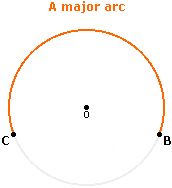
A major arc is an arc larger than a semicircle. A central angle which is subtended by a major arc has a measure greater than 180°.

A chord, a central angle or an inscribed angle may divide a circle into two arcs. The smaller of the two arcs is called the minor arc. The larger of the two arcs is called the major arc. In the illustrations below the circle is divided into two arcs, minor arc BC and major arc BC.

Minor arcs are named with the word "arc" or the words "minor arc" and two or three letters (usually two letters). For example arc(BC), minor arc(BC), arc(BDC) and minor arc(BDC) all refer to the minor arc shown in the illustration below. For the minor arc example below, arc(BC) or minor arc(BC) would probably be used.

A circle is associated with a complete rotation, which is 360°.
A semi-circle is associated with half of a rotation which is 180°.
Minor arcs are associated with less than half of a rotation, so minor arcs are associated with angles less than 180°.
Major arcs are associated with more than half of a rotation, so major arcs are associated with angles greated than 180°.
Since the point of rotation is always the centre of the circle, CENTRAL ANGLES are used to describe the "measure" associated with an arc.